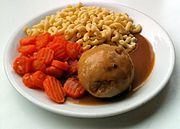Caul fat
 From Wikipedia the free encyclopedia
From Wikipedia the free encyclopedia

Caul fat, also known as lace fat, omentum, crépine or fat netting, is the thin membrane which surrounds the internal organs of some animals, such as cows, sheep, and pigs, also known as the greater omentum. It is used as a casing for sausages, roulades, pâtés, and various other meat dishes.[1] Examples of such dishes are Swiss atriau,[2] French crépinette,[3] Cypriot sheftalia, South African skilpadjies, British faggots,[1] Serbian plućna maramica and trbušna maramica and Italian fegatelli. In the traditional Ukrainian and Russian cuisine, caul fat, known as salnik or salnyk, was usually filled with kasha and liver, and baked in a clay pot in the Russian oven.[4] The Navajo people of the Southwestern United States wrap sheep intestines around strips of caul fat to make a dish called ach'ii'.
- Caul fat dishes
- Salnyk
- Ostrich crépinette
- French veal sausage bundle (Feuilleton de veau)
- Atriau served with pasta and carrots
References[edit]
- ^ a b "Caul fat recipes". BBC Food. Retrieved 23 November 2022.
- ^ Association Fribourgeoise des Paysannes (1996). Küche & Traditionen im Freiburgerland (in German). Fribourg: Éditions Fragnière. p. 133.
- ^ "Crépinette". Food Dictionary. Epicurious.com. Retrieved 23 November 2022.
- ^ Pokhlyobkin, William (2010). "Salnik". The Great Encyclopedia of Culinary Art (in Russian). Moscow: Centrpoligraph. ISBN 978-5-9524-4620-5.
Further reading[edit]
- Shorland, F. B.; Jessop, A. S. (October 1955). "Isolation of Δ9 Heptadecenoic Acid from Lamb Caul Fat". Nature. 176 (4485): 737. doi:10.1038/176737a0. PMID 13265818. S2CID 4295106.
- Weenink, R. O. (September 1956). "Octadecadienoic Acids of Lamb Caul Fat". Nature. 178 (4534): 646–647. Bibcode:1956Natur.178..646W. doi:10.1038/178646b0. PMID 13369494. S2CID 41278582.
- Hamilton, Bradford S.; Paglia, Diana; Kwan, Anita Y. M.; Deitel, Mervyn (September 1995). "Increased obese mRNA expression in omental fat cells from massively obese humans". Nature Medicine. 1 (9): 953–956. doi:10.1038/nm0995-953. PMID 7585224. S2CID 24211050.



